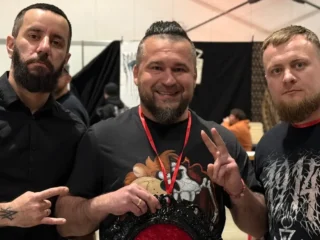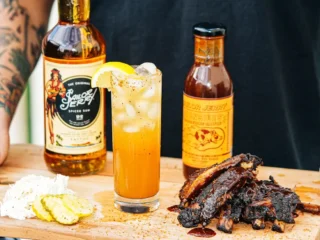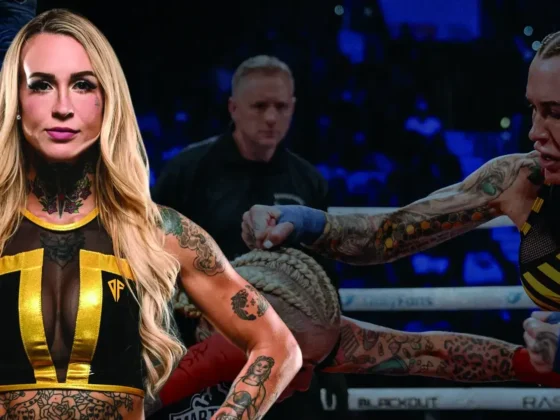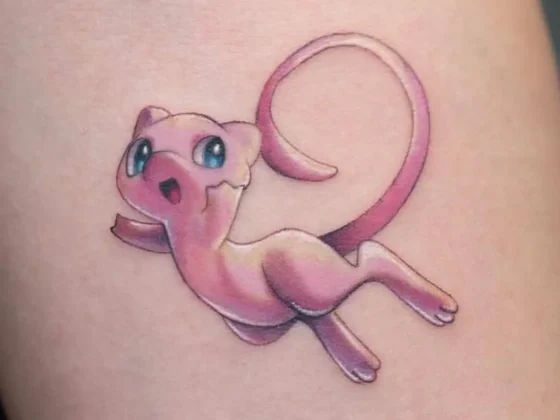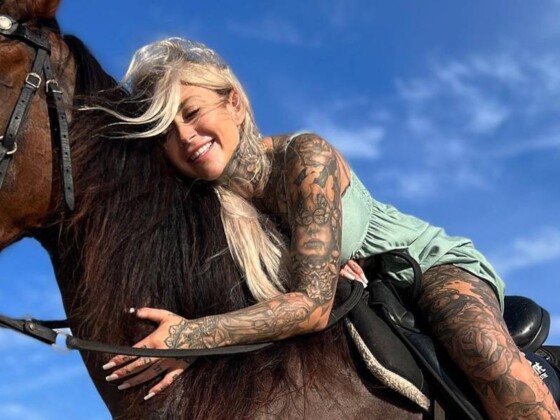Devon Preston
June 11th, 2019
Table Talk: Get to Know Celebrity Chef Chris Santos
How Chris Santos went from culinary student to world-renowned restaurateur
For the past 30+ seasons, Chris Santos has served as a recurring guest judge on Food Network’s “Chopped.” However, this is far from his biggest claim to fame in the culinary industry. For the past several decades, Santos has owned and operated some of New York City’s top-rated restaurants. We sat down at his latest launch, the Lower East Side’s street art-inspired Vandal, to learn about his entry into the culinary arts and how he built a restaurant empire in the most competitive food city in the world.
How did the food you ate growing up inspire a passion for the culinary arts?
Well, it didn’t. My passion for the culinary arts started from my first night working in a kitchen when I was about 13 or 14 years old. The chef quit in the middle of my first shift and pandemonium ensued. My recollection was that it was a complete disaster. But the adrenaline rush of everyone moving as fast as possible and trying to salvage the night somehow grabbed me by the teeth and sunk into me. Soon after, they hired a new chef and that chef took me under his wing. Then I started paying attention to food. Up until that point, I was a TV dinner kid. My mom was working multiple jobs and I had to fend for myself. But once I started working in restaurants, my eyes opened wide to everything that was out there. Then after culinary school, I spent a significant amount of time backpacking through Europe and eating. That’s when my full-blown love affair with food really started

Despite attending culinary school, you’ve described yourself as self-taught. What does it mean to be a self-taught chef?
Typically speaking, the ‘proper career path’ would be after culinary school, to do a bunch of stints under world-renowned chefs to be mentored and taught. It’s a great path, but it’s not the path that I went on. After culinary school, I basically stepped out into the world and got my first executive chef position, which I was completely ill equipped for. I had no idea what I was doing, so I learned on the job. That’s what I mean by being self-taught, I never had a true chef mentor.
What don’t they teach you in school that you find valuable in your career?
The hours are brutal and if you don’t truly love what you do, this isn’t the right industry for you. It can be really hard on relationships because you’re not around a lot and there are long shifts. But it’s also incredibly rewarding. The bonds that I’ve formed with people who have chosen the same profession are lifelong bonds.
Upon graduating from culinary school, you moved to New York City. Why did you choose New York?
Well, Sinatra said: ‘If you can make it here, you can make it anywhere.’ Also New York being — some other cities may disagree — the foremost food city in the country, if not the world. Certainly Paris, San Francisco, and a multitude of other cities around the world can lay claim to it, but I’m still loyal to New York. Coming out of culinary school, I felt that New York was the biggest mountain to climb. Although I will say that when I moved here, I was 21 and I had a nine-year plan. I was going to do three years in New York, three years in New Orleans, and three years in San Francisco — which would bring me up to 30, and then I’d decide where I wanted to be. But here I am, 26 years later. I think it’s the most challenging place in the world and Sinatra was right.
Between 1999 and 2000, you traveled to 14 countries and visited over 40 cities. What were the most valuable skills that you picked up during that time?
Believe it or not, nothing technical. It was really more about developing my palate and introducing my senses to just how complex food is and flavors are. It was eye opening, whether it was walking down a street in France with a baguette or having an ahead-of-its-time molecular gastronomy dinner in Spain. It was an unbelievable educational experience, eating more than actually cooking.

Before turning 30, you opened your first restaurant, Wyanoka. What led you to open a restaurant at such a young age?
What led me to open up a restaurant at such a young age was foolishness. I re-calibrated my nine-year plan soon after I moved to New York. One of the things about New York is that the greatest restaurants in other cities rival the greatest in New York. But what other cities don’t have is the fact that there are great restaurants on every block in New York. I fell in love with that and I fell in love with the city, specifically the Lower East Side. I knew that around year three, when I should have been shipping off to New Orleans, that I wasn’t going anywhere. So I re-calibrated and said, ‘Now I want my goal to be opening my first restaurant before I’m 30.’ Which I did when I was 28 and it put me on the map. I got my first New York Times review, I got great press, and it opened doors to where I am today. If you traced back all the steps, none of this would have been possible without that restaurant. But I didn’t know what I was doing, so I was losing money as fast as I could make it and not being very efficient. But I wouldn’t trade the experience for anything.
Five years later, you opened The Stanton Social. How would you describe the atmosphere and how did you develop the signature style of that space?
Stanton Social was the first place where I truly cooked the type of food that speaks to me. I had been letting my brain lead me up until that point, and I then started letting my palate and my stomach lead me in the right direction. I also knew that I wanted to bring back the Convivio family-style concept of dining. I intentionally set out to be a restaurant that was a big group kind of celebratory spot where people would come for birthdays, bachelor/ bachelorette parties, and anniversaries, but be encouraged to share food. I mean, I have a cookbook called “Share,” it’s kind of my whole thing. Up until this point, I hadn’t done that and I’d worked in the traditional appetizer, entree, dessert system of restaurants. Once I broke out of that and started making food more interactive, there’s an energy in the room that creates a buzz and excitement that I found lacking before that.
Then we have Beauty & Essex. What went into curating this space and creating a multi-layered dining experience?
Essex street, it’s not the prettiest street in New York City. So we knew we were going to build this beautiful restaurant that had a secret entryway. Not to be a cliche sort of speakeasy, but to provide a transportive experience where you would go in and then open up the doors into this grand space. I had partners and we’d dabbled in a few different ideas, but once we came upon doing a jewelry-inspired pawn shop, it made us go back to the drawing board and we designed the restaurant with jewelry tones everywhere. Once that happened, everything fell into place and I think it’s one of the most beautiful restaurants on Earth. I know that I’m biased, but it’s just so beautiful. Then I took the Stanton Social concept of shareable dining and elevated the cuisine. Where the Stanton Social has fun and inventive versions of corn dogs, Beauty & Essex is a little more refined.

Last, but not least, we have Vandal, which takes inspiration from street art. What set this establishment apart from your other restaurants?
Vandal has creative, globally-inspired cuisine with street art from around the world. We have an incredible collection of street art, both framed pieces and actual installations. We pair these great street art murals with really inventive, creative cuisine that also draws inspiration from all over the world. Vandal takes inspiration from both Stanton Social and Beauty & Essex, in terms of having higher-end items and fun, everyday food too.
What are your thoughts on how tattoo culture and tattoos have infiltrated the restaurant world? I mean, it’s almost a cliche now, right?
I think chefs are a little tired, myself included, of being lumped in as bad boy chefs because we have tattoos. But it is part of the fabric of kitchen culture. Why that is, I couldn’t necessarily speak to the sociological reasons for it, but there is a pirate-type of lifestyle back there. You work 12 to 14 hour days, six days a week, weekends, holidays, and happy hour is at 2 a.m., not 6 p.m. It’s an alternative lifestyle to be a chef, and I think what often goes along with alternative lifestyles are tattoos.
Your cookbook “Share” revolves around communal-style dining. What’s your favorite memory of sharing a meal?
I don’t get to cook much more as a chef, my role has changed into running restaurants, managing teams and developing new concepts. So my cooking time becomes less and less every year, but the holidays bring my family and my fiance’s family together. I go to Kansas and cook this big, lavish dinner for 20 people. Everyone gets involved and that’s my favorite time of the year.
Having worked in New York for several decades, what are your top 3 underrated spots in the city?
Macondo, on First Avenue and East Houston. It’s a great little spot that doesn’t get a lot of play in the press, but it’s great for tapas and reasonably priced wine. Then there are the ABC Restaurants: ABC Kitchen, ABC Cocina, and ABCV. I feel like ABC Kitchen and ABCV get a lot of attention, but ABC Cocina is one of the best Mexican restaurants in the city. Third, the burger at the Dram Shop in Park Slope, Brooklyn. It’s maybe the best burger I’ve had in New York City and we always get lists of the best burgers but they’re not on it. And a fourth one, is Don Pepi, a hole-in-the-wall pizza shop in Penn Station, of all places. You would never think you’d be able to find really good food at Penn Station, but Don Pepi’s pizza is my favorite place in the city.
What’s your biggest piece of advice for aspiring chefs and restaurateurs?
I would always advise young aspiring chefs and restaurateurs to, before they go to culinary school and make that commitment, spend a year working in the industry. It is very rewarding but it does take a lot of hours and sacrifices for many years. So I think that you need to spend a year working in a restaurant or kitchen just to see if you can hang with that. Then, after a year, if you feel good about it and you still love it, by all means, pursue your dream.
Editor's Picks
Chris Brown’s Face Tattoo Shows His Heart and Sole
Chris Brown has a brand new tattoo! Long gone are the days of the baby faced teen, Brown is all grown up and has the tattoo collection to prove it!…
Oh Me, Oh My
Chrissy Chlapecka on finding her voice, spreading self-love on TikTok and releasing her first single




